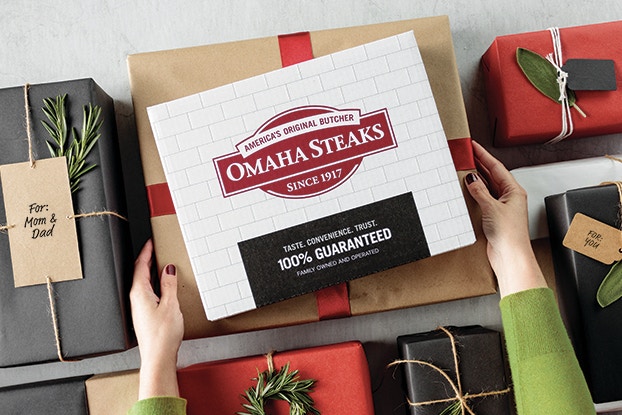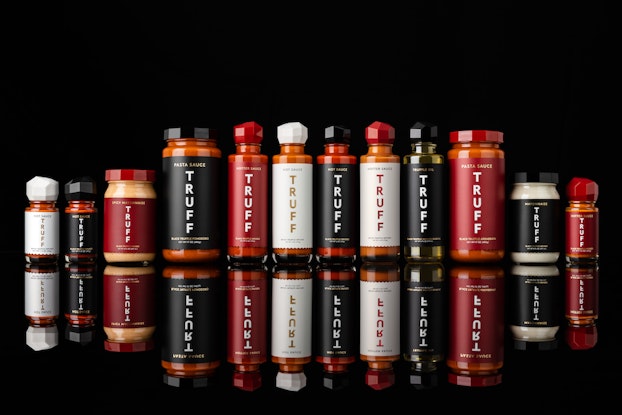
How Albertsons, Omaha Steaks and TRUFF turned pandemic pivots into business gains:
- Albertsons’ digital transformation tapped tech to help in-store associates expedite online orders and customers populate digital grocery lists more easily, wooing new e-commerce shoppers to the supermarket chain.
- Omaha Steaks leaned into its upscale food assortment, such as Butcher’s Cut filet mignons, boosting purchasing frequency and customer-retention rates.
- Buzzy hot sauce disruptor TRUFF scaled its inventory management functions to handle bigger orders to meet heightened demand, fueling product expansion and the brand’s growth in 15,000 retail doors.
The pandemic forced Albertsons, Omaha Steaks, and hot sauce disruptor TRUFF to pivot fast to fulfill the sudden surge in both food demand and online grocery orders from consumers sheltering in place.
Those pivots unwittingly prepped the brands for the COVID-stoked shifts upending the food industry today. As the nation’s remote-work-fueled, at-home eating habits and growing appetite for online grocery shopping appear to stick, the legacy brands and buzzy startup are reaping long-term gains from their quick-turn pandemic strategies, executives from the companies told CO—.

Interested in a small business membership?
Find out how the U.S. Chamber of Commerce can help your company grow and thrive in today's rapidly-evolving business environment. Connect with our team to learn how a small business membership can benefit your bottom line and help you achieve your goals.
Albertsons: A digital transformation spells opportunity, as ‘e-commerce is attracting new customers’
When the pandemic hit, Albertsons, which operates over 2,200 supermarkets in 34 states, found itself ill-equipped to handle the sudden surge in online orders. “We knew right away that we needed a different approach in store to manage those orders,” Chris Rupp, Chief Customer and Digital Officer for Albertsons, told CO—.
Albertsons was not alone. The grocery sector was notoriously late to the e-commerce revolution.
E-commerce generated a mere 6% of U.S. grocery sales in 2019, according to Insider Intelligence. That number has nearly doubled post-pandemic, as digital channels are expected to generate 11.2% of the $1.32 trillion in U.S. grocery sales this year.
Albertsons, fortuitously, had just embarked on a multimillion-dollar digital transformation. So, it fast-tracked the revamp to meet the moment.
The goal, according to Rupp, was to “translate changing customer expectations into an incredible digital shopping experience from pre-purchase to delivery.”
E-commerce generated a mere 6% of U.S. grocery sales in 2019, according to Insider Intelligence. That number has nearly doubled post-pandemic, as digital channels are expected to generate 11.2% of the $1.32 trillion in U.S. grocery sales this year.
Amid the rise in online grocery shopping, Albertsons built its own picking app to help in-store associates process e-commerce orders faster and more efficiently.
Then it upped convenience via a customer-facing app that wades through thousands of SKUs to serve up groceries that match consumers’ eating occasions and “need states,” Rupp said, whether they’re planning weekly meals or buying replenishment items like milk. A recipe feature lets customers select the ingredients for a dish and then populates a shopping list.
And leaning into the widespread adoption of third-party delivery services, Albertsons partnered with DoorDash to offer DoubleDash, a service that enables consumers to tack on an order from a local restaurant or retailer like Walgreens to their Albertsons orders, sans added delivery fees.
The moves have paid off, modernizing the chain to better compete in a grocery landscape rocked by digital disruption that’s fed consumers’ heightened demand for tech-enabled convenience, speed and personalization, Rupp said.
Pre-pandemic, Albertsons delivered groceries in about 24 hours, Rupp said. “Now you can get your delivery in two hours in 80% of our markets. We had e-commerce in 500 stores in 2019, and now it’s in 17,000,” she said. “E-commerce is attracting new customers.”

Omaha Steaks: Doubling down on upscale cuts boosts everyday purchases and customer retention rates
Omaha Steaks, the 105-year-old mail-order food business, seized on the opportunity to capture an everyday consumer as the pandemic took hold.
It hoped to improve customer retention rates, increase purchase frequency, woo new customers, and reactivate lapsed ones.
“When people think of Omaha Steaks, they tend to put us in a gifting or special occasion category,” Julie Evans, Vice President and Chief Marketing Officer, told CO—.
“During the pandemic, we were humbled and honored to help so many customers stay in and stock up for their at-home dining needs. With the shift in opportunity, we leaned into what makes our products truly the best. From aging to trimming to portion size, we changed the specifications of our product by providing even more value to the customer and elevating the items on our menu.”
Pre-pandemic, for example, the brand aged its beef — “an age old-art that takes time, precision and investment” that yields a more tender and flavorful steak — for 21 days, compared to competitors’ 14 to-21-day aging process, Evans said. The brand upped the ante, aging every steak on its menu from sirloin to filet mignon between 28 and 35 days.
“We began aging our steaks longer during the pandemic as part of our ‘never satisfied’ mentality,” Evans said. “This is expensive for us to do as it costs us to hold steaks longer. But it has paid off with a 13% increase in customer retention.”
And as consumers gravitated toward higher-end fare, the brand invested in its premier Butcher’s Cut steak line trimmed by its 80 “master butchers.”
“We had introduced our first Butcher’s Cut steak right before the pandemic, but then decided during the pandemic to double down on it and make it the focal point of our steak assortment,” she said. “We saw that customers were positively responding to an improved product experience and, as a result, we wanted to offer them that experience across each of our main cuts.”
Omaha Steaks worked across its marketing, production, and product development teams to expand and promote the line. “And now, two years later, our Butcher’s Cut steaks are the largest volume-driving category in our portfolio,” she said.
Customers are liking the changes, Evans said. “We’ve seen an improved rebuy rate of our customers buying for themselves compared to our prior trends,” Evans said.
“This puts us in a position to be the first choice on the plate and will take our 105-year-old company through the next 100 years.”
[Read: 3 Startups in Fast-Growing Niches Detail Plans to Accelerate Business in 2022]

TRUFF: Pandemic-fueled supply chain upgrades drive product growth and expansion in 15,000 retail doors
TRUFF’s pandemic-forced pivot pushed the hot sauce brand to scale its inventory management functions to handle bigger orders to meet heightened demand for items like its signature black truffle hot sauce.
“We were carrying more inventory on hand than usual, what some would deem risky,” Nick Ajluni, Co-Founder and Co-CEO, told CO—. “We did our best to predict demand, then strategically place larger orders. The challenge is to do this in a way that is financially responsible. We worked closely with our suppliers, co-packers, and various ops teams to do this in the most stable way possible.”
For TRUFF, the risk proved fruitful, girding both its product expansion and a bigger presence in 15,000 retail doors today from Kroger and Whole Foods to Target.
“We were able to stay in stock as well as open many new retail accounts, as well as service our DTC customers with as few delays as possible,” he said.
TRUFF’s supply chain upgrades also supported the successful launch of three product extensions through the pandemic, including pasta sauce, mayonnaise, and truffle oil, Ajluni said.
"In 2020, we noticed consumers started seeking out new and unique flavors to add excitement to their meals while they were cooking at home. While we started development of our pasta sauce prior to the pandemic, we felt with more people cooking at home that it was a great time to launch our first-ever product extension. From there, we placed a strong emphasis on product innovation and development. With each expansion, we put premium, stylized spins on consumer categories that have been historically dominated by legacy brands, whether it was the pasta sauce, mayonnaise, or truffle oil category,” Ajluni said.
Investing in the well-being of its team amid the pandemic, from their mental health to compensation needs, also paid off for the brand.
“As far as our team goes, we not only retained our entire team, but also added roughly 40% more team members since the start of the pandemic,” he said.
CO— aims to bring you inspiration from leading respected experts. However, before making any business decision, you should consult a professional who can advise you based on your individual situation.
Follow us on Instagram for more expert tips & business owners’ stories.
CO—is committed to helping you start, run and grow your small business. Learn more about the benefits of small business membership in the U.S. Chamber of Commerce, here.







